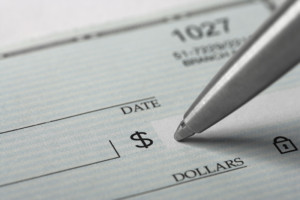How to Spot an Altered Check

Thieves alter checks by changing the amount or the payee name. Then, they cash the check over the counter, deposit it into a new account and withdraw the funds before anyone detects anything or find other methods of getting the cash. To spot altered checks, keep the following tips in mind.
1. Look for Inconsistent Handwriting
When accepting checks for deposit over the counter, your tellers should look for handwriting inconsistencies. If they see differences between the amount and the payee name or other handwritten details on the check, they may want to investigate a bit more before accepting the check.
3. Check for Visible Signs of Alteration and Erasure
Your tellers should also look for visible signs of alteration when accepting checks for deposit. If they can see that the amount has been changed or if there are erasure marks underneath the payee name, they should follow the protocol you have laid out. Depending on the situation, you may want to put a hold on the check, reach out to the check issuer, or contact the bank from which the check is drawn.
3. Tell Customers Not to Leave Spaces
If your customers leave spaces when they write out checks, that can make their checks more susceptible to alteration. Ideally, they should fill up the check amount box and the line where they write out the check amount. Consider sending out samples of how to write out checks properly whenever your customers order a new box of checks.
4. Advise Customers to Keep Checks Safe
Checks need to be stolen before they can be altered, and to prevent that from happening, your customers need to keep their checks safe. They shouldn’t leave checks unattended in desk drawers at work or in unlocked cars. Ideally, they shouldn’t even put checks for bills into their mailboxes, as thieves are notorious for grabbing and altering checks from this vulnerable location.
5. Be Aware of Internal Risks for Corporate Clients
Check tampering often tends to affect corporate or business clients more than individuals. Make sure customers with business accounts are aware of the risk of internal fraud, and consider urging them to implement the following safeguards:
- Limit access to checks to certain employees.
- Have a clear chain of custody for checks from the time they are written until they are signed and dispatched.
- Keep vendor lists up to date to ensure no one is issuing checks to fake vendors.
- Destroy voided checks.
- Embrace built-in check security methods such as watermarks or security threads.
- Use electronic payment methods when possible.
6. Offer Positive Pay to Your Customers
Perfect for corporate customers, positive pay allows your customers to submit a list of the checks they issue every month or statement period. Then, special software automatically compares incoming checks with the amounts and payees specified by your customers. When aberrations pop up, the positive pay software alerts you so that you can manually review the check and reach out to your customer as needed.
7. Consider Using Security Seals
You may also want to offer business account holders the technology to print security seals on their checks. With SENTRY: Seal, your customers can print a seal or barcode onto their checks, which contains all the information (amount, payee name, date, etc.) from the check. When your financial institution accepts the check, SENTRY: Seal compares the information encoded into the seal or barcode with the details written on the check and notifies you of discrepancies.
8. Urge Account Holders to Report Stolen Checks
Let both your business and personal account holders know about the importance of reporting stolen checks. Then, whether they lose a few check blanks or a whole box of checks, you can issue a stop payment on all the checks in that series. Similarly, if your customers write out a check to someone who loses it, they should always be proactive about reporting the missing check so that no one finds it, alters it, and cashes it.
To encourage customers to make these reports, you may want to offer to stop a certain number of checks for free every year. That way, your customers don’t avoid making a report because they don’t want to pay the stop check fee.
9. Use Automated Check Image Analysis Tools
Unfortunately, even if your tellers are extremely well trained and have a keen eye for fraud, they are going to miss some altered checks. To minimize your losses, you should consider investing in check fraud analysis tools. Products such as SENTRY: Inspect and SENTRY: Content automatically look over the stock elements and content on on-us checks, and they detect minute issues that are not perceptible to the human eye alone. Then, these products present suspicious checks in a workflow application so that your employees can make a decision manually.
Knowledge and training are key to avoiding fraud, but you also need the right tools in place. At SQN Banking Systems, we help our clients automate fraud detection so that they can save time, reduce labor, and minimize fraud. Let us help you protect your reputation and your bottom line — contact us today to learn more about our products and services.
